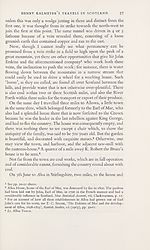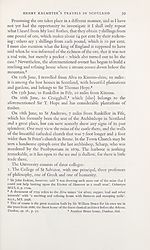Series 4 > Scottish industrial history
(83) Page 38
Download files
Complete book:
Individual page:
Thumbnail gallery: Grid view | List view

38
SCOTTISH INDUSTRIAL HISTORY
estate of Sir John Erskine, Knight Baronet, on whose land, half a
mile from the house, lies that silvermine which recently caused so
great a stir in Scottland on account of its richness. An Englishman
named Peck, who came up to Scottland to look for metals in several
places, had in 1714 taken the opportunity of a narrow strip of
white sparr, or rock, running up right across a high mountain, to
go in there prospecting, and when he had hardly come one yard, a
gland of silver was discovered which was not only rich in itself but
also contained pieces or lumps of solid silver which I have seen
myself. However, since such mines are regale, they found it expedient
to work so quietly that no-one heard anything in particular about
it, and they smelted the best of the ore as well as they could at home
in the house, in great pots or crucibles with lead, also refining it: this
I heard from an Edinburgh goldsmith who said he had witnessed
one such smelting when they obtained 6 or 700 ounces of silver.
However, the rebellion came to Scottland in 1715 and 1716, and
Sir John Erskine took part in it, so that he was later forced to retire
from the country along with many others. But when he heard that
he ran a risk of loosing his estate, he made a proposal to the govern¬
ment through his friends that if he could be granted a pardon he
would reveal a rich silver mine, and this he obtained. He and his
mines were afterwards left free except that he should pay the
crown one tenth of the silver he could work, and certain people are
sent from the mint at London to make an examination at the
place.1
Consequently, they also began to extend the work at four places
just above each other, obtaining a considerable quantity of ore of
several sorts, until these gave out completely. At the time I was there
nothing was to be seen of them, although the work continued and
they had entered 10 or 12 fathoms with their tunnels, blasting with
gunpowder where the rock was hard.
1 This account is borne out by the Paul MSS in N.L.S., which further explains that
James Hamilton, an English workman who had been employed by Sir John to refine
the ore before the latter went into the rebellion (with six servants and a tenant), and
had then been made overseer of the mines, made off in March 1716 with a sample of
the ore which he took to London and showed to the Lord Mayor. Hamilton spoke
of 433 oz. of silver refined in eight days, and of 40 tuns of ore packed in barrels and
buried near the house. It is not very clear how Sir John got his estate back as the secret
had already been revealed by the workman. N.L.S., MS. 5160.
SCOTTISH INDUSTRIAL HISTORY
estate of Sir John Erskine, Knight Baronet, on whose land, half a
mile from the house, lies that silvermine which recently caused so
great a stir in Scottland on account of its richness. An Englishman
named Peck, who came up to Scottland to look for metals in several
places, had in 1714 taken the opportunity of a narrow strip of
white sparr, or rock, running up right across a high mountain, to
go in there prospecting, and when he had hardly come one yard, a
gland of silver was discovered which was not only rich in itself but
also contained pieces or lumps of solid silver which I have seen
myself. However, since such mines are regale, they found it expedient
to work so quietly that no-one heard anything in particular about
it, and they smelted the best of the ore as well as they could at home
in the house, in great pots or crucibles with lead, also refining it: this
I heard from an Edinburgh goldsmith who said he had witnessed
one such smelting when they obtained 6 or 700 ounces of silver.
However, the rebellion came to Scottland in 1715 and 1716, and
Sir John Erskine took part in it, so that he was later forced to retire
from the country along with many others. But when he heard that
he ran a risk of loosing his estate, he made a proposal to the govern¬
ment through his friends that if he could be granted a pardon he
would reveal a rich silver mine, and this he obtained. He and his
mines were afterwards left free except that he should pay the
crown one tenth of the silver he could work, and certain people are
sent from the mint at London to make an examination at the
place.1
Consequently, they also began to extend the work at four places
just above each other, obtaining a considerable quantity of ore of
several sorts, until these gave out completely. At the time I was there
nothing was to be seen of them, although the work continued and
they had entered 10 or 12 fathoms with their tunnels, blasting with
gunpowder where the rock was hard.
1 This account is borne out by the Paul MSS in N.L.S., which further explains that
James Hamilton, an English workman who had been employed by Sir John to refine
the ore before the latter went into the rebellion (with six servants and a tenant), and
had then been made overseer of the mines, made off in March 1716 with a sample of
the ore which he took to London and showed to the Lord Mayor. Hamilton spoke
of 433 oz. of silver refined in eight days, and of 40 tuns of ore packed in barrels and
buried near the house. It is not very clear how Sir John got his estate back as the secret
had already been revealed by the workman. N.L.S., MS. 5160.
Set display mode to:
![]() Universal Viewer |
Universal Viewer | ![]() Mirador |
Large image | Transcription
Mirador |
Large image | Transcription
Images and transcriptions on this page, including medium image downloads, may be used under the Creative Commons Attribution 4.0 International Licence unless otherwise stated. ![]()
| Scottish History Society volumes > Series 4 > Scottish industrial history > (83) Page 38 |
|---|
| Permanent URL | https://digital.nls.uk/126656007 |
|---|
| Description | Over 180 volumes, published by the Scottish History Society, containing original sources on Scotland's history and people. With a wide range of subjects, the books collectively cover all periods from the 12th to 20th centuries, and reflect changing trends in Scottish history. Sources are accompanied by scholarly interpretation, references and bibliographies. Volumes are usually published annually, and more digitised volumes will be added as they become available. |
|---|


